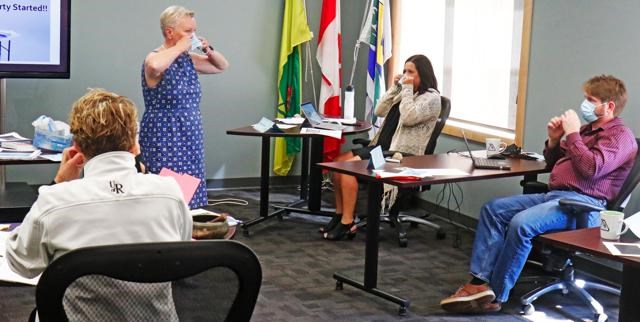When schools in the Holy Family Roman Catholic Separate School open for the new school year on Tuesday, Sept. 8, a primary goal for educators will be to reduce the risk of transmission of COVID-19.
Training in how to handle the pandemic in their schools were provided to school principals on Friday morning, and will also be given to teachers, caretakers and bus drivers before the doors open to students on Sept. 8. A registered nurse, Joan Pratchler, was brought in by the school division to provide a detailed presentation about what COVID is and how to handle it.
As Holy Family is under Level 2, like all other school divisions, students in Grades 4 to 9 will be required to wear masks in high-traffic areas where physical distancing is not possible, such as on buses or in the hallways between classes.
Explaining in laymen’s terms what the COVID-19 virus is, she also explained the how and why of actions like hand-washing, distancing and mask-wearing in response.
Pratchler noted that COVID-19 is an acronym for “Corona Virus Disease discovered in 2019”, and that it is a virus, not bacteria.
Bacteria are large and have a developed system, with bad ones secreting an endotoxin that will cause the host to become sick. A virus, on the other hand, is very small, and is comprised of a fatty exterior with RNA protein inside which injects the RNA into a host cell to infect it.
The virus was compared to a gang member, in that it co-opts the body’s cells to do its dirty work for them. The body needs its immune system to fight a virus by using antibodies.
As Pratchler explained, it takes time for the body’s system to recognize that a virus has invaded, and to build up an army of antibodies to fight the virus. Problems arise if a person’s immune has been compromised in any way (such as by cancer treatments), or is already dealing with other health issues, such as asthma, diabetes, rheumatoid arthritis, COPD or if the person is obese.
Methods by which the virus is transmitted are through droplets of saliva and mucus, which can be spread by talking, singing, or coughing and sneezing. The bigger droplets won’t travel far, but fine droplets which can carry a tiny virus can travel much farther — thus medical experts recommend the two-metre (six-foot) physical distance.
A fine droplet can be as tiny as less than five microns. To give an idea how small this is, a human hair can be between 60 and 120 microns wide.
To fight it, the main important points include hand hygiene, physical distancing, wearing of PPE and cleaning and disinfecting of any high-traffic surfaces.
On hand-washing, Pratchler noted that soap and water is good for ridding the virus off the hands, but hand sanitizer will actually kill the virus. Washing works insofar as the hands are rinsed with fresh, flowing water, but it does not kill the virus.
PPE such as face shields, gloves and masks provide a barrier of sorts, and cleaning and disinfecting reduces the viral load by killing any viruses present on high-touch surfaces.
“You can kill bacteria and you’re done. Anti-virals don’t kill it, but stops it from reproducing so much,” she said. COVID’s target when it invades the body is to hit the lungs, and in turn this reduces the output of oxygen to the body’s organs like the heart and kidneys.
“We’re reducing the viral transmission by reducing the viral load, so that’s why we clean. You wash your hands so the viral load is depleted, and you reduce the risk of viral transmission,” said Pratchler.
She did a hands-on demonstration of putting on an N-95 mask, and the basic disposable face mask that most people wear. Most people will not need an N-95 mask, as it is for health care workers, such as nurses — and even at that, it keeps out 95 per cent of viruses, with a five-per cent chance it can still get in.
As for the disposable masks, she said, “It keeps your chunks in, but it won’t keep anything from getting in.”
For when students need to wear them, she told the principals if the masks get wet at all they should be thrown away and replaced, and recommended they not be worn outside at recess time.
Principal Dean Loberg of St. Michael School asked how this situation will work as students need to wear them in the hallways heading out to recess, but not wear them when they’re outside.
He noted they will be staggering the recess times, and will use the school’s five exits to cut down on any crowding in the hallways.
Pratchler said if the students are kept in their cohort groups and staff cleans when they can, this might reduce the need for masks somewhat. Part of her inservice with staff was going to be at St. Michael, and she said she would have a look at how the school was set up in order to have a better answer as to how to handle mask-wearing.
The schools will also have an isolation room, which will be used if a child is sick at school and needs to be picked up by a parent to go home. The use of PPE by staff would likely only need to be worn there in the event a child has a bad cold, or might have signs of COVID.
On the question of whether children should be bringing their own hand sanitizer to school, Pratchler advised against children having alcohol-based sanitizer, as it is actually a poison if ingested, and there is too much risk for children to be harmed by it.




